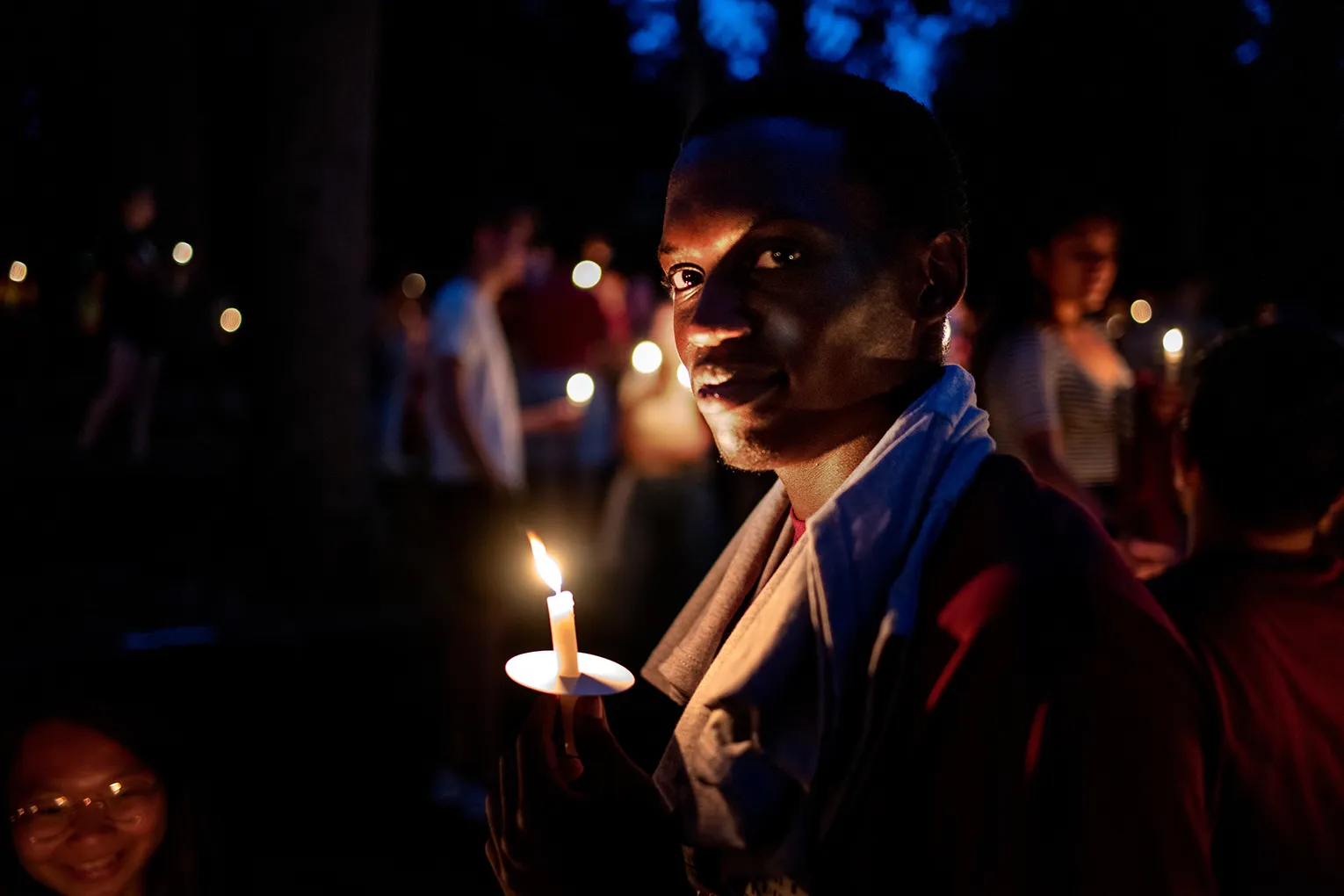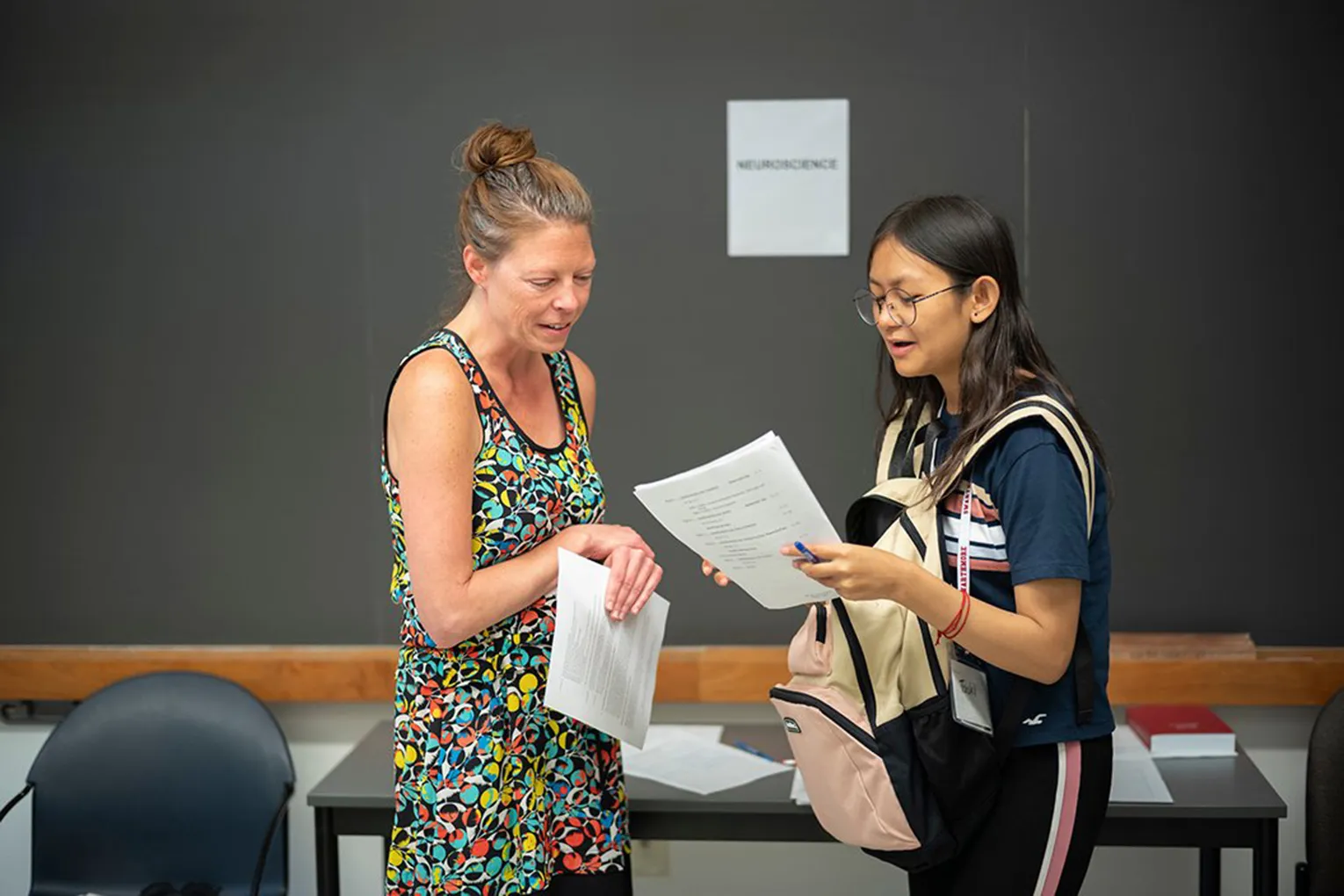The Swarthmore College Orchestra Performs April 26th in Lang Concert Hall

On Saturday, April 26, the Swarthmore College Orchestra will perform Dmitri Shostakovich's Fifth Symphony, two pieces with the winners of the Concerto Competition—a student competition held by the orchestra each year to determine the spring semester soloist—and an original composition by T Sallie ’25. The performance, directed by Andrew Hauze ’04, is the culmination of a semester’s worth of rehearsals and work to bring together an extensive and varied program.
“The orchestra has been working hard since the beginning of the semester to perform the wide variety of music on this program,” Hauze said. “The biggest piece is the Fifth Symphony by Dmitri Shostakovich, an extraordinary, epic 55-minute piece that challenges all of us on technical, musical, and emotional levels.”
Hauze says this year’s performance covers a broader range of musical expression than years prior and is a not-to-be-missed experience. The orchestra will occupy almost every inch of the stage for the Fifth Symphony. “There's nothing quite like experiencing the grandeur of a symphony like the Shostakovich!”
Ava Pressman ’25 and Olivia Scarozza ’25, the latter a percussionist with the orchestra, will perform the "Christe Eleison" movement from J.S. Bach's B Minor Mass, following their success at the Concerto Competition. Roger Wang ’25, the third competition winner and principal bassoonist, will perform the last movement of the "Grand Concerto for Bassoon" by Johann Nepomuk Hummel.
“The Bach and Hummel are the perfect foils to the intensity of the Shostakovich: the Bach has a dancing, warm quality, filled with beautiful interwoven voices, and the Hummel is a whimsical and jolly feature for the bassoon,” Hauze said.
Pressman said she and Scarozza entered the concerto competition because they were excited by the prospect of performing with an orchestral accompaniment. They selected the Bach piece following a suggestion from their vocal teacher, Clara Rottsolk. Both living in New York City, they met over winter break to rehearse and then continued practicing with an accompanist during the spring semester. “Performing in the competition made me a little nervous because it was my first time participating in something like this. However, the atmosphere was super supportive and warm; we were all there to support each other.”
Scarozza said she and Pressman are excited to perform the piece along with instrumentation, as it was intended when composed. Scarozza’s recent rehearsals with the orchestra have involved figuring out the correct tempo and balancing the instruments and vocal elements. “It's a tricky piece, and I'm not sure it's ever going to feel super comfortable for me, but it's such a pleasure to sing with the instrumentalists and with Ava, that it's worth the anxiety!”
Wang also began practicing frequently during winter break and selected Hummel’s bassoon concerto due to its difficult nature, and the joyful tone of the last movement. “This is in fact a very famous and popular piece among bassoonists. It is technically difficult compared to many other standard concertos that we would play for competitions or concerts, and I have only heard this piece live once, when I was attending a nationwide competition in Beijing.”
Wang says he is honored to have the opportunity to perform with the orchestra. “Our orchestra has incredible members, and I'm filled with excitement but also humility every single [rehearsal]. While this is certainly a new experience, preparing for this concerto allowed me to further appreciate the talent that is here in the orchestra and at Swarthmore, and I'm learning so much from Andrew and my fellow colleagues.”
T Sallie’s original composition for the performance, Seastorm, combines drama and playfulness, according to Hauze. “It's always thrilling to work on the premiere of a new piece, and it's particularly nice to have T, who is also our principal cellist, sitting right next to me so I can ask him questions whenever they arise, and T can give the whole orchestra feedback on how he'd like the piece to sound,” Hauze said.
Sallie said they did not have a clear inspiration when writing Seastorm, rather a sudden vision. Luckily, they were able to quickly get to a piece of paper and pen and write it down before it was lost forever.
“When I'm composing, I'll often have a musical motif enter my mind at the most inopportune moments, like walking to class, being in class, or some other event where I can't immediately record myself humming the melody or get my cello out to expand it further,” Sallie said. “For this piece, I think I was walking somewhere when the opening idea came to me, and even though it's simply descending thirds, I was worried I would lose the rhythm of it and any further ideas after that opening phrase followed by the timpani solo.”
When composing, his greatest worry has been creating a balanced piece, both through editing software with electronic playback and in practice. Sallie says balancing sound between instruments with varying timbres and dynamic capabilities is difficult. “It was a surreal moment to see my own work sitting on all the stands in the hall, with the score on Andrew's conductor stand, looking so official, knowing that I'd personally suffered several painful hours of formatting to make it all presentable.”
As weeks of rehearsals have gone by, Sallie says Seastorm now feels like any piece he has practiced before with the orchestra, which has been an enjoyable experience. He says he is still amused when Hauze turns to him to ask for feedback on a section as the composer, having to switch quickly from his role as a cellist to the sole composer.
The orchestra will perform on April 26 at 8 p.m. in Lang Concert Hall. The concert is free and open to the public.



